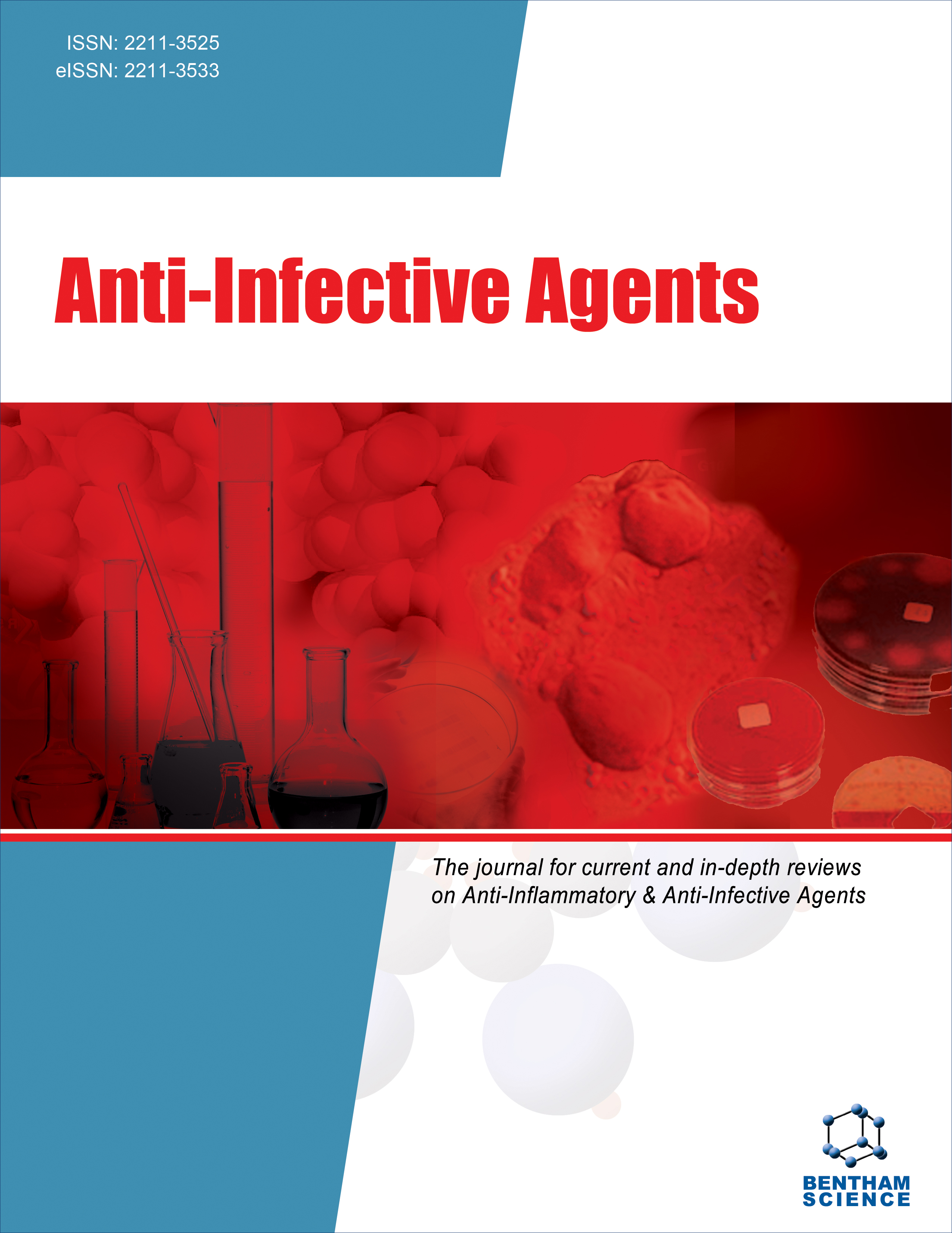- Home
- A-Z Publications
- Anti-Infective Agents
- Previous Issues
- Volume 10, Issue 1, 2012
Anti-Infective Agents - Volume 10, Issue 1, 2012
Volume 10, Issue 1, 2012
-
-
Antibacterial and Hemolytic Activities from Piper montealegreanum Yuncker (Piperaceae)
More Lesss The emergence of new bacterial strains with multiple resistances may lead to the emergence of new hospitalacquired infections that result in high mortality. Research on new antiinfectives must therefore be continued and all possible strategies should be explored. Screening of plant extracts as well as secondary metabolites, aiming to highlight the presence of new compounds with antimicrobial activity is a potential s Read More
-
-
-
Synthesis and Anti-tubercular Activities of Benzo[4,5]furo[2,3-c] Chromen -6-one Derivatives
More LessAuthors: Noopur Srivastava, K. S. Anil Kumar, Sudhir Sinha, Ranjana Srivastava and D. K. DikshitSynthesis and in vitro anti-tubercular activity against Mycobacterium tuberculosis H37Ra and H37Rv of a number of 3-hydroxy[2,3-c][1]benzopyran-6(H)-ones 1a-f and 3-Benzyl-8-hydroxy-1,2,3,4-tetrahydro-chromeno[3,4- c]pyridin-5-ones 8a-c has been reported. Few of the compounds exhibited anti–tubercular activity with MIC as low as 3.12 μg/ml in virulent and avirulent strains.
-
-
-
Preclinical and Clinical Aspects of Antimicrobial Drugs Delivered Through Ethosomal Vesicles
More LessAuthors: Nida Akhtar and Kamla PathakAs skin is an integumentary organ of the body, it acts as the portal of entry for extraneous substances for their effective topical and transdermal delivery. Possessing various advantages, it has the limitation of low permeability of drugs across it, limiting the efficacy of drugs. Therefore, various carrier systems have been developed to enhance the permeation to the deep tissues. Most recently, ethosomes have been developed a Read More
-
-
-
Antibacterial Activity of Some New Azole Compounds
More LessAuthors: S. Khabnadideh, Z. Rezaei, Y. Ghasemi and N. Montazeri-NajafabadyThe development of antimicrobial agents to treat infections has been one of the most notable medical achievements of the past century. Despite the growing list of azoles, their clinical value has been limited by their relatively high risk of toxicity and the emergence of drug resistance. This necessitates the development of more effective broad spectrum antimicrobials with fewer side effects. We previously described the desi Read More
-
-
-
Recurrent Hepatitis C After Liver Transplantation
More LessRecurrent HCV is universal after liver transplantation in patients viremic at the time of transplantation and leads to cirrhosis in up to 30% of patients by five years. Once cirrhosis develops, the risk of hepatic decompensation is 42% per year. This has led to recurrent HCV emerging as an important yet controversial indication for liver retransplantation and a renewed interest in the role of anti-viral therapies. Despite encouraging res Read More
-
-
-
2D- and 3D-QSAR Studies of Flavonoids, Biflavones and Chalcones: Antiviral, Antibacterial, Antifungal, and Antimycobacterial Activities
More LessAuthors: Andrew G. Mercader and Alicia B. PomilioFlavonoids comprise a group of naturally occurring compounds that are known by their biological properties. Antiviral, antibacterial, antifungal, and antimycobacterial activities were analyzed. The results were discussed in terms of the bioactivity tested, and the structure-activity relationship (SAR), bidimensional (2D)- and three-dimensional (3D)- quantitative structure-activity relationship (QSAR) studies carried out on flavones Read More
-
-
-
Molecular Modeling Studies, Synthesis and Biological Evaluation of Novel Plasmodium falciparum Lactate Dehydrogenase (pfLDH) Inhibitors
More LessIn silico methods have been used to identify five different classes of compounds as inhibitors of the essential Plasmodium falciparum enzyme lactate dehydrogenase (LDH). The molecules were assayed for in vitro antimalarial activity in both cell- and enzyme-based inhibition models. 5-Bromo-2-hydroxypyridine-3-carboxylic acid 19 is the most active with IC50 of 3.5 nM for chloroquine sensitive and 5 nM for resistant stra Read More
-
-
-
Synthesis and Antimicrobial Activity of Some Novel Schiff's Bases of 4-Methyl-2-Thiazolamine
More LessAuthors: M. Rudrapal, B. De and N. DevannaIn the present study, some novel Schiff's bases of 4-methyl-2-thiazolamine were synthesized by condensation of 2-amino-4-methylthiazole with different substituted aromatic aldehydes. Structures of newer Schiff's bases were established on the basis of IR, 1HNMR, Mass spectral data and elemental analyses. All the synthesized compounds were obtained in good yields and high purity. The antimicrobial activity of the synthe Read More
-
Most Read This Month
Article
content/journals/aia
Journal
10
5
false
en


